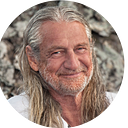The Tool of Mantra | Mark Whitwell on Whole Body Yoga
Mark Whitwell | Heart Of Yoga
In the traditions, Yoga was always taught on a one-to-one basis.
When you meet with your Yoga teacher, the most essential aspects of life are discussed: your connection to God/Reality, your relationships, your family life, your sexual practice, your career, your desires.
There is a saying,
“When these matters are spoken of only four ears should be present.”
It is the teacher’s job to help the student to go in the directions that are right for them. The teacher supports the students’ movement from being swept along within the patterning (samskara) of family and society into their autonomous adult life — as a flower blooming in their own garden.
The main method of transformation is the personal love-relationship that you enjoy with your teacher — an actual relationship of mutual affection between friends, not a professionalized or medicalized role-play, but a natural and dear friendship.
In such a relationship, something magic happens. When we discover that we can fully trust another, we develop trust in ourselves. We gain the confidence to step through doubts and fears. We can fall down, get up, fall again, shed tears, and press on, gradually mastering our movements and refining our directions, knowing we are supported by real affection.
My teacher TKV Desikachar would say,
“The relationship between the teacher and the student is the heart of Yoga”
Within this intimacy, certain practices are given for the empowerment of the student. The teacher and the student negotiate a practice that is made up of some or all of the technology of the tantra — asana, pranayama, meditation, visualization, yantra, and mantra.
A daily Yoga practice comprised of these elements is our direct embrace of the essential peace and power of life/God; our participation in the polarities of strength-receiving that constitute their embodiment; our means of abiding as the power of the cosmos that is arising within the One reality in which everything is happening.
Mantra
Mantra is a powerful tool that can be included in a student’s daily vinyasa. If the student has an interest in mantra then it can definitely be utilized.
Mantra is typically associated with religious culture, but it does not have to be. And neither does not have to be any kind of formal mantra. For example, you can replace the exhale during asana with the simple sound “Ah Ham.”
For many people mantra does have a religious meaning. I remember Desikachar teaching a group of Christians and including the mantra “Amen” at the end of the practice with a long drawn out ‘Ah’ sound rising from the base of the body. And a soft “men” sound as the vibration moved to the head.
For Hindu devotees, you may include mantra from the Upanishads or the Bhagavad Gita.
Or it could even be a lyric from your favorite poet or artist that has a personal resonance for the student. I have a friend in France who deeply loves Bob Dylan. So we turned the chorus of his song into a mantra for his Yoga practice.
We do mantra to feel the fundamental unity of body and mind. It is the whole body (mind included) that gives us the capability of making sound. And when we engage sound as the whole body, feeling the mantra move from base to crown, we longer imagine that mind has a dissociated life of its own.
Read More:
